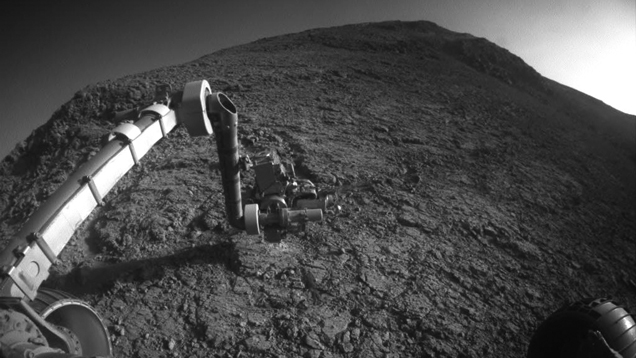Scientific Adventures: NASA rover gives a dozen reasons to celebrate Mars
 CREDIT: NASA/JPL-CALTECH
CREDIT: NASA/JPL-CALTECHNASA's Opportunity Rover captured this photograph at the edge of the 22 kilometre wide Endeavour Crater on its 11th anniversary.
The pursuit of knowledge on Earth is still going strong, but for this week’s scientific roundup the focus will be off-planet.
Smith Cloud on edge of Milky Way a “boomerang”
Astronomers have analyzed data from a well-known gas cloud at the edge of the Milky Way Galaxy (MWG), determining not only its origins, but also where it’s headed.
Using the Hubble Telescope orbiting 600 kilometres above Earth, and a combination of ultraviolet light from three different galaxies behind Smith Cloud, the team determined the outer space object was ejected from the MWG about 70 million years ago.
In 1963, Dutch-American astronomy student Gail Smith discovered radio signals traveling through space made by hydrogen, and predicted that Smith Cloud is set to crash back into the galaxy’s edge in about 30 million years, much like a boomerang returning to where it was thrown.
Originally theorized to be interstellar dust or remnants of a failed galaxy, the more likely origins of Smith Cloud were determined by testing its chemical composition, which happened to contain large amounts of sulfur. The element is found in large amounts at the edges of the MWG, but is almost non-existent in interstellar dust.
The discovery is important because it shows the MWG has a type of recycling system for expelled matter. When Smith Cloud finally returns, it will create an astronomical nursery, birthing millions of young stars.
Opportunity going strong over a decade after touchdown
On Jan. 24 NASA rover Opportunity celebrated its 12th anniversary since landing and beginning operations on Mars, long surpassing its original 90 day primary mission goal.
The rover has endured seven long winters on the red planet, as a Martian year lasts 687 Earth days, and has been studying the landscape at the edge of the 22.5 kilometre wide Endeavour Crater since 2011.
Despite it currently being winter on Mars, strong winds helped clean off the rover’s solar panels, allowing Opportunity to continue more energy intensive operations including driving and rock grinding, both of which are needed to properly prepare samples for analytical experiments by the onboard spectrometers.
Opportunity holds the record for the most distance travelled on another astronomical body, clocking over 42 kilometre on the Martian surface, quite a bit farther than the original 600 metre operating limit.
Opportunity was the second rover in a twin probe mission to Mars back in 2004, landing 21 days after its robotic sibling Spirit. NASA ended the Spirit mission in 2011 after the rover became trapped in a sand dune and was having power spikes, eventually becoming a stationary science platform until it lost contact with NASA.
Harsh environment tests wrapping up on ISS
After circling the Earth over 8,500 times aboard the International Space Station (ISS), the European Space Agency (ESA) has a package ready to come home.
Filled with 46 microorganisms and over 150 organic compounds, the EXPOSE-R2 module was retrieved and brought aboard on Feb. 3 by cosmonauts Yuri Malenchenko and Sergei Volkov in a five and a half hour spacewalk that also included the installation of specialty handrails for future spacewalks and a new bonding materials experiment.
For the last 18 months the EXPOSE- R2 experiment module was attached to the outside of the Russian Zvezda module, which supplies the ISS’s entire life support system. The samples were exposed to the rigours of outer space with conditions including multi-hundred degree temperature fluctuations, intense cosmic radiation and the vacuum of space.
When they are returned to ESA scientists, the various biological and biochemical samples will be compared to 225 control samples that never left Earth.
Next week’s adventures will cover cybernetic breakthroughs and rocket news back on Earth.














